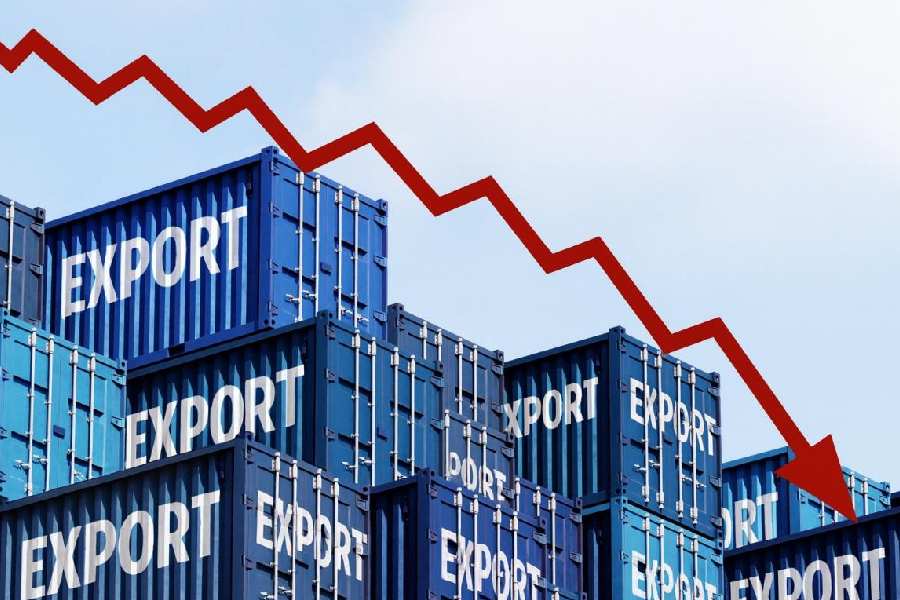India’s goods exports are cracking under the pressure of US tariff actions and broader global weaknesses. The fault lines have widened into the external account, pushing the rupee to its lowest value last week, while exporters — especially small and medium-sized firms — continue to face sustained pressure. October’s steep export decline was broad-based and across nearly all product groups, except marine and electronics, with the labour-intensive gems and jewellery segment taking the sharpest hit. Year-to-date goods-export growth is considerably weaker than last year across most major destinations, signalling that the problem extends beyond tariffs to a larger slowdown in global demand.
This comes at a time when trade-supportive measures have dominated economic policy. Three trade pacts have been signed; a fourth — with the United States of America — is reportedly close to finalisation, and more are at various stages of negotiation. These efforts were reinforced last Friday when the government pushed forward on long-pending labour reforms. Four labour codes on wages, industrial relations, social security, and occupational safety and working conditions — passed by Parliament five years ago but not operationalised — were finally notified. The key changes include allowing fixed-term contracts, effectively relieving domestic firms of long-term employment liabilities and raising the threshold for layoffs without government permission to 300 workers — with scope for states to revise these further.
These policy moves mark a substantial departure from the rising protectionism of recent years. They also come at a time when most of the world, especially advanced nations that constitute crucial export markets, is retreating from globalisation and rolling out industrial policies to relocate production domestically. Trade partnerships and agreements are being reshuffled, with the WTO-overseen, rules-based multilateral system rapidly giving way to an expanding and confusing set of bilateral and regional arrangements. The prospects for world trade have, therefore, become deeply uncertain, just as the global economy has slowed and is forecast to continue slowing.
India’s export-oriented policy efforts thus confront fierce headwinds — not only weak global demand but intense competition from Asian peers that have historically exported their way to prosperity, enabling vast labour shifts out of agriculture. Many of these economies have become preferred destinations for entrepreneurs and firms relocating from China. Even during the turbulence this year, relative newcomers like Vietnam recorded strong export growth, including in October, while India faltered. In the post-pandemic period (2022-24), when the global economy has been slowing continuously, both Vietnam and China increased their world export shares while India’s slipped.
This divergence and lagging highlight India’s sharp dependence on the global economic cycle. Indian exporters struggle to offset external demand shocks through productivity improvements even as competitors succeed in circumventing these. This long-standing vulnerability likely discourages domestic firms from expanding into export markets and from making sustained investment commitments toward overseas demand.
An equally troubling trend is the structural weakening of competitiveness over time. In the 1990s, India’s goods exports grew at an average pace of six percentage points above world GDP growth. In the decade to 2019-20, that advantage halved. After the sharp fall in world trade volumes in 2012, India’s goods-export growth averaged only one percentage point above world GDP in 2014-24. Another illustration comes again from Vietnam, which nearly tripled its share of world exports from 0.6% to 1.7% during this period, almost equalling India’s 2024 share of 1.8%. India had begun the decade at 1.7%, highlighting a decade of stagnation.
The consequences are critical macroeconomically. Difficulty in retaining market share and tapping external demand means lower contributions of exports to national output. Exports or external demand is the fourth component of GDP alongside private consumption, investment, and government expenditure. Its underperformance explains why both investment and employment growth have remained sluggish for more than a decade.
For a country aspiring to achieve developed country status within the next 12 years and harness its demographic dividend, India will need to grow at least 7% a year and, ideally, at 8%. Exports are indispensable to this objective. Beyond augmenting aggregate demand, exporting transforms incentives because it pushes firms and sectors toward greater efficiency, scale, and capability upgradation under global competition, thereby reshaping the production structures as resources are directed at their most advantageous and productive. The history of sustained fast growth across
the world bears this out; no large economy has achieved it without strong
export expansion. Moreover, robust exports strengthen the balance of payments — a point brought into sharp relief by the recent sudden drop in the rupee following an unexpectedly wide October trade deficit driven by both weak exports and an exceptional surge in gold imports.
Against this backdrop of weakening export competitiveness and a fading growth impulse from global markets, policy has pivoted toward structural reforms aimed at boosting competitiveness. Labour-market liberalisation seeks to reduce rigidities that restrain labour-intensive manufacturing, while trade agreements aim to secure market access. The impact of these structural interventions will take time and only be visible over the medium-term. Outcomes will depend critically on implementation — both of the labour codes domestically and of trade agreements by all sides. The road ahead is demanding, above all because external competition is tougher than ever. It is also continually shifting as trade agreements are renegotiated and the geography of competitiveness reshaped. It must also be hoped that policy focus does not skip back to protecting domestic businesses on the way.
Renu Kohli is Senior Fellow, Centre for Social and Economic Progress, New Delhi. Views are personal

